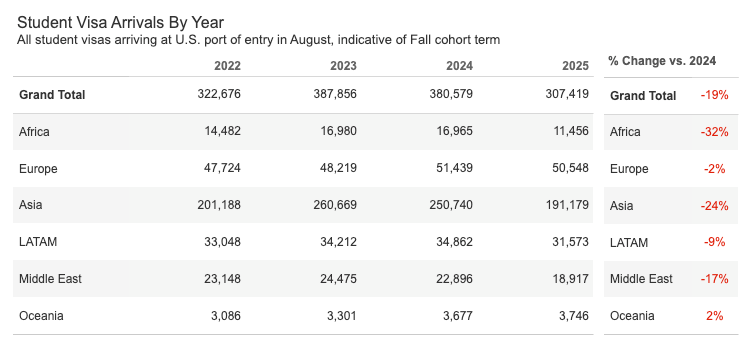New figures from the U.S. International Trade Administration show a sharp drop in international student visa arrivals through August 2025. Compared with August 2024, the US welcomed 73,000 fewer students, a decline of 19.1%. Universities across the country are reporting the same trend on their campuses.

Asia is driving the overall decline: A loss of nearly 60,000 students year over year (a 24% drop) accounts for most of the 73,000 decline. A large portion of this is India, which itself saw a -44% decline this August compared to last year.
Africa’s decline is proportionally worse (32%), though smaller in absolute numbers.
Europe is resilient, showing only a slight dip.
Oceania is flat to positive, but has very little impact on totals.
Check out more trends on Shorelight’s dashboard. It is important to note that the I-94 form tracks all student visas arriving in the US, not only new students.
Given the above, the economic stakes are high. NAFSA warned earlier this year that a sustained drop in international enrollments could cost the US $7 billion. Shorelight’s own analysis suggests the current decline could mean $1.7 billion in lost tuition revenue each year, growing to $4.9 billion over the course of students’ full degree programs. Yet the losses go far beyond finances: America is also losing access to global talent during a moment of fierce international competition in technology and innovation.
Higher Education Under Strain
For generations, US colleges and universities have represented the American Dream. Thousands of institutions across the country have attracted students with diverse choices in size, location, and cost, creating a system unmatched in scale and quality. But that reputation is now under pressure.
Rising tuition, declining state support, and heightened political scrutiny have eroded confidence in higher education. Federal actions targeting universities — whether on endowments, free speech, or research funding — have created further uncertainty, especially for prospective international students. At the same time, more American students are pursuing higher education abroad, with rising applications to universities in Europe, the United Kingdom, and Asia.
Warning Signs of a Brain Drain
These trends raise a profound concern: for the first time, the US faces the possibility of a brain drain.
Researchers leaving the US: Both domestic and foreign-born academics are being recruited by countries making large-scale investments in research and development.
Soft power at risk: Restrictive visa policies and fewer international exchange opportunities threaten to diminish America’s cultural influence.
Eroding prestige: In 2015, US universities accounted for 46% of mentions in Times Higher Education’s survey of the world’s leading teaching and research institutions. By 2025, that number had fallen to 38%. Over the same period, Chinese universities rose from 2% to 7%, with Tsinghua University and Peking University both entering the global top 15.
Other nations are seizing this moment, actively courting international students who might once have chosen the US. Top institutions abroad are positioning themselves as welcoming alternatives, diverting talent that traditionally flowed to universities across America.
A Crossroads for US Competitiveness
Higher education is central to America’s economic strength, its culture of innovation, and democratic values. American universities and colleges nurture critical thinking, civic responsibility, and global collaboration. Yet current policies risk weakening these pillars just as international competition intensifies.
If the US seeks to remain the world’s premier destination for education and research, it must reconsider the direction of its higher education policies. Reputation alone will not sustain leadership. Decisions made now — on tuition, funding, immigration, and global engagement — will shape whether the US continues to attract the world’s brightest minds, or whether that mantle shifts elsewhere.
Sources
U.S. Economy Could Suffer a $7 Billion Loss from Precipitous Drop in International Students
Targeting higher education is an essential tool in the autocratic playbook
From Brain Gain to Brain Drain: The Cost of Undermining U.S. Higher Education
The U.S.’s Global Standing In Higher Education Is Slipping—Can It Recover?

